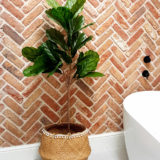Brick slips, often referred to as brick tiles, provide an aesthetic appeal resembling traditional bricks but are notably thinner and more versatile. Choosing the right adhesive is crucial for ensuring their durability and effectiveness.
Understanding Brick Slip Adhesive
Brick slip adhesive is a specialized material used to securely attach brick slips to various surfaces. It is designed to handle significant weight and resist environmental factors.
Factors to Consider When Choosing Brick Slip Adhesive
Selecting the right adhesive involves considering its strength, compatibility with environmental conditions, and drying time. Each factor plays a crucial role in the installation’s success and longevity.
Preparing for Installation
Proper surface preparation and having the right tools are foundational steps in ensuring that the adhesive bonds effectively.
Steps in Applying Brick Slip Adhesive
The process includes mixing, applying, and allowing the adhesive to set. Each step must be carefully executed to avoid issues during and after installation.
Tips and Tricks for Effective Application
Managing environmental factors such as temperature and humidity is essential. Additionally, special techniques may be needed for challenging surfaces.
Common Mistakes to Avoid
Inadequate mixing of adhesive or rushing the curing process can compromise the installation’s integrity.
The Durability and Maintenance of Adhesive-Bound Brick Slips
With proper installation, brick slips can last many years with minimal maintenance. Understanding how to care for them can extend their lifespan significantly.
Repairing and Replacing Brick Slips
Procedures for removing damaged brick slips and applying new adhesive are crucial for maintaining the aesthetic and structural integrity of the installation.
Innovative Uses of Brick Slips in Modern Architecture
Brick slips are not only functional but also offer creative flexibility in design, contributing to modern architectural aesthetics.
Conclusion
The right adhesive is key to successful brick slip installations. Emphasizing best practices ensures both aesthetic appeal and structural integrity.
FAQs
- What is the best adhesive for exterior brick slips?
For exterior brick slips, the best adhesive to use is our Rapid Set Tile Adhesive, we’ve tried and tested this for several years and it’s proven to be the best Brick Slip Adhesive on the market from our experience. - Can brick slip adhesive be used in high-moisture areas?
Yes, specific types of brick slip adhesives are suitable for use in high-moisture areas. Adhesives that are specifically formulated to be moisture-resistant, such as those based on epoxy or polymer-enhanced cement, are recommended for areas exposed to high levels of humidity or direct contact with water. These adhesives prevent moisture penetration, reducing the risk of damage or detachment over time. - How long does brick slip adhesive take to cure?
The curing time for brick slip adhesive can vary depending on the type of adhesive used and the environmental conditions during application. Typically, cement-based adhesives take about 24 to 48 hours to set initially, but achieving full strength may take up to 28 days. Epoxy-based adhesives might set quicker, generally within 6 to 8 hours, but also require several days to fully cure. Always check the manufacturer’s guidelines for specific curing times. - Is it possible to DIY brick slip installation?
Yes, it is entirely possible to DIY brick slip installation, especially if you are handy and have some basic understanding of masonry or tiling. DIY enthusiasts will need the proper tools and materials, such as notched trowels, spirit levels, and the appropriate adhesive. It’s crucial to carefully prepare the surface and follow detailed instructions for mixing and applying the adhesive to ensure a successful and durable installation. - Are there environmentally friendly brick slip adhesives?
Yes, there are environmentally friendly options available for brick slip adhesives. These adhesives are typically low in volatile organic compounds (VOCs) and may be made from natural or recycled materials. Eco-friendly adhesives also often feature a reduced carbon footprint and improved indoor air quality properties. When shopping for green adhesive options, look for certifications or labels that indicate the product meets environmental and health standards.


































